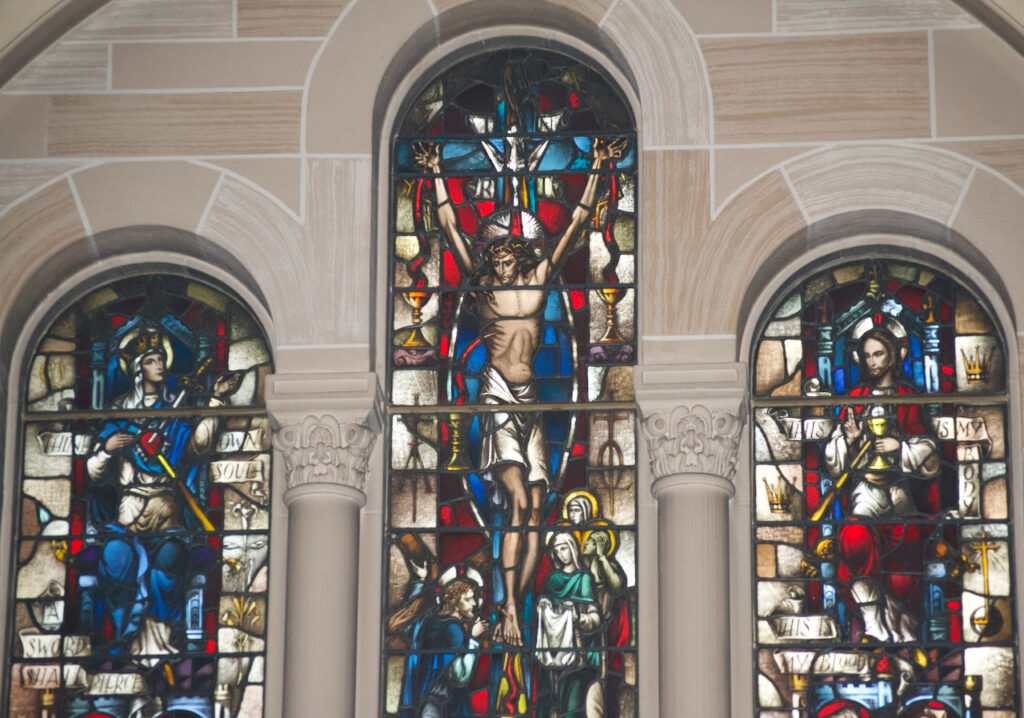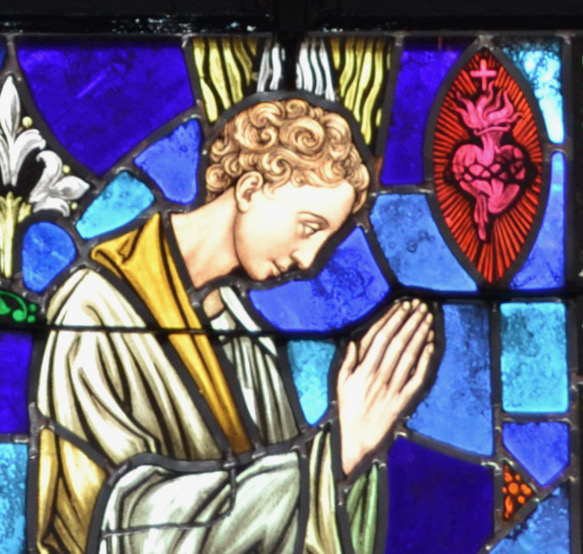
During the past week, the Church celebrated the Solemnities of the Body and Blood of Christ and the Sacred Heart of Jesus, and the Feast of the Immaculate Heart of Mary. All of these feasts have their origin in the passion, death and resurrection of Jesus. Much has been written about them by saints and commentators. They are depicted in an interesting combination of images in the top half of the triptych window over the altar dedicated to the Passionist St. Gabriel Possenti. Reflecting on these windows in prayer can help us connect these feasts to our own lives, especially during this return to ordinary time in the liturgical year.
The central image of the window is Jesus on the cross, his side pierced by the lance and chalices collecting the blood from his
wounds (see The Cross of Christ post). In the pane on the right, Jesus is seated in heaven, holding a chalice and host, the Eucharist, his sacred Body and Blood, offered by Him to God and given to his apostles on Holy Thursday, and offered for our redemption on the cross on Good Friday. Around the image of Jesus are the words, “This is my Body. This is my Blood”, the words He spoke at the Last Supper. In the Eucharist Jesus is truly present to us, providing the grace to believe, to hope, and to love as we walk through our everyday lives. The orb with the cross that is beside Jesus’ throne reminds us that He offered his Body and Blood for all people in all time.
On the left side of the crucifix Mary is enthroned in heaven, her heart pierced by a sword. The words in the scrolls around her are the words Simeon prophesied at the Presentation of Jesus when He was an infant, “Thine own soul a sword shall pierce.” These words capture Mary’s pain as she watched the suffering and death of her Son. Even though this is not the image of the Immaculate Heart of Mary as it is usually portrayed, it does have elements of that image and reminds us of the perfect love that Mary has for her Son. Beside Mary is the lily, symbolizing her purity. A ray of light extends from Mary’s pierced heart. A similar ray extends from the chalice that Jesus is holding. Both might symbolize the grace and love that extends to one who is particularly devoted to Mary in her pure love for her Son, and to the Body and Blood of Jesus, freely given by Him to us, who are in need of His mercy and love.
The image of the Sacred Heart of Jesus is found in one of the baptistry windows. It is also associated with the crucified Christ (see the first post about Baptism). It is the image of Jesus’ pierced heart, encircled with a crown of thorns and on fire with love for all people. Devotion to the Sacred Heart of Jesus can help us to live out our baptismal promises.
All three feasts celebrate the infinite and unconditional love that Jesus has for each one of us, the love he showed us on the cross. The Immaculate Heart of Mary also expresses the perfect love that Jesus’ mother had for him. Mary has that love for us also, and can lead us to loving her son as she does. As we reflect on these Feasts and the images in the windows may we draw closer to Jesus in love. May we approach the Eucharist with hearts open to receive the love of God. And may we learn to love Jesus with our whole being as Mary did.
